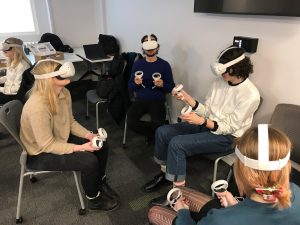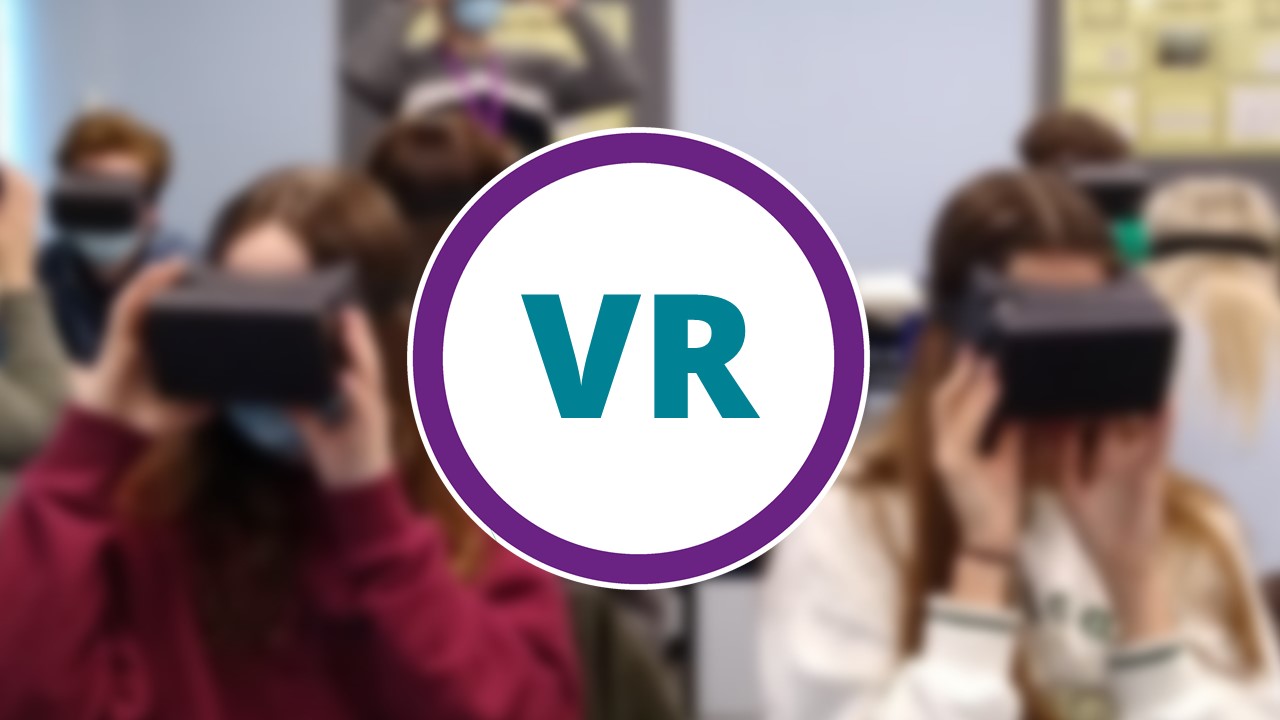Why we went on a spacewalk: Supporting intended learning outcomes with virtual reality (VR) in seminars
 The primary teaching objective was to enhance awareness on the Overview Effect as part of a wider discussion on the sustainability and equity of human activity in outer space, through the mediation of immersion and enjoyment (Lin et al. 2020). This was also an opportunity to develop the digital skills of students by introducing them to virtual reality software and familiarising them with the Meta Quest 2 headset.
The primary teaching objective was to enhance awareness on the Overview Effect as part of a wider discussion on the sustainability and equity of human activity in outer space, through the mediation of immersion and enjoyment (Lin et al. 2020). This was also an opportunity to develop the digital skills of students by introducing them to virtual reality software and familiarising them with the Meta Quest 2 headset.
Working with two staff and equipment from the Humanities eLearning Team, I ran a seminar using Meta Quest 2 virtual reality headsets to engage students in an immersive outer space experience. The session ran in three parts, beginning with an introduction to the headsets and software (First Steps), followed by students running two programs on outer space (Mission ISS; Space Explorers). We then ran a virtual debrief (vTime XR).
In lectures I had already spoken to the students about the Overview Effect as described by astronauts, which encouraged them to imagine the perspective of seeing the Earth from space, a perspective that most of us are unlikely to have ourselves as space travel remains for the privileged few. Watching the spacewalk allowed students to go beyond merely imagining themselves in a different world, toward creating an immersive sense of seeing this perspective themselves via the digital realm. Exploring the space station gave them an opportunity to situate this perspective by exploring where the astronauts live and work when in low earth orbit.
None of the students had used virtual reality headsets before and so the first half of the session was focused on familiarising them with the headsets. To address this challenge and further develop their digital skills, students were allowed to take the headsets home and use them for the rest of the month.
Following the session and working with the teaching and learning team I conducted two surveys, one immediately after the session and one at the end of the month. I received 8 responses for the first survey and 9 for the second survey. I also discussed the session with students in class and using discussion tool Piazza. Data was coded thematically to collate positive experiences and challenges identified by the students. View student comments in the Student Feedback section below.
Student Feedback
POSITIVE EXPERIENCES
Immersive / perspective
“I was surprised at how immersive an experience it was – I thought that I would be able to separate the view from the real world but found it surprisingly hard not to feel like I was *in* the view. I’ve seen views of Earth from the ISS/orbit before but it was very different seeing it through the headset, and I found it much more “real”. I was not expecting it to feel so different!”
“Good to see things in that perspective, very realistic. The space walkers video put everything into scale”
“I did not realise it would be so immersive, it was really cool to be able to pick stuff up and move around in the VR simulation”
“How immersive it felt!”
Beauty and awe
“My experience was that it felt really real and the earth looked beautiful”
“The nothingness of space was particularly striking juxtaposed with the awesomeness of the Earth”
“Seeing Earth from outer space makes me realise how fragile earth is”
“The endless nothingness and darkness was striking and quite shocking. That put into perspective how important Earth is.”
“How massive the spaceship was also astonishing to see through VR.”
As a learning activity
“It’s a very engaging way of learning, fun and multimedia”
“It was different from other classes because it was more active and you could move around a bit and see more stuff than just pictures on a PowerPoint screen”
“helped to develop discussion”
“It…complicated my personal opinion on contemporary space travel and environmentalism. It definitely gave me an insight into the experiences and emotions of astronauts seeing the Earth from space”
“The spacewalk was good at transporting us to space – the darkness was quite strong at demonstrating the Overview Effect which we talked about in class. Definitely put a lot of what we talked about in class into perspective.”
CHALLENGES
Dizziness and balance
“I felt a bit dizzy during the last session, and it felt a bit uncomfortable in the beginning when looking down at the earth”
“Dizziness with the ISS training module”
“I lost my balance a couple of times in the ISS video, it did not make me uncomfortable but I could have easily fallen over!”
“After about 10 minutes my eyes were strained and I felt very dizzy. It is not something that can be done repeatedly or for long periods of time”
The space walking app did very quickly induce motion sickness, but I never felt pressured to continue with it, and it was still a good experience.
“There was times where I felt slightly dizzy and nauseous, but otherwise I felt okay.
Headset issues
“The weight of the headset on my forehead”
“Glasses issues – even with the bracket, and the headset is large and heavy so rests are needed”
Benefits
- This was a learning activity which enhanced the Intended Learning Outcomes for knowledge and understanding in relation to the Overview Effect, particularly on core concepts and key debates.
- It was an immersive experience that the students enjoyed, which opened discussion on the Overview Effect in the debrief.
- In feedback, students discussed the beauty and awe of seeing the Earth from Space, which is a key element of the Overview Effect and had been difficult to communicate in a lecture format.
- Enhancing the digital skills of students, none of which had used virtual reality headsets before.
Top Tips
- We are early adopters of VR technology and must experiment with different options. Co-producing future sessions is a good idea, and collecting student feedback to reflect on what did and didn’t work is essential.
- Communicate with students that this is an experimental session and seek their input on how it should be run / how it can be improved: key to ensuring its success in future years.
- The individualised experience of virtual reality makes it suited to some students more than others and so the technology should be used to enhance existing ILO’s rather than writing new ones.
- VR is (for now) human resource intensive and needs multiple staff to ensure student safety and (if holding a virtual seminar) to manage a session across virtual and physical locations.
- Less is more: the technology is immersive and overwhelming on first use and the session would have been more useful and less tiring if we had focused on the training program and the documentary Space Explorers.
References
Advance HE. (2019). Professional Standards Framework for teaching and supporting learning in higher education 2023. Advance HE. [online]. Available from: https://www.advance-he.ac.uk/knowledge-hub/uk-professional-standards-framework-ukpsf [Accessed June 28, 2023].
Jones, P. et al. (2022) Virtual Reality Methods: A Guide for Researchers in the Social Sciences and Humanities. Policy Press. [online]. Available from: https://library.oapen.org/handle/20.500.12657/57076
Lin, Y., Wang, G. and Suh, A. (2020). Exploring the Effects of Immersive Virtual Reality on Learning Outcomes: A Two-Path Model. In D. D. Schmorrow & C. M. Fidopiastis, eds. Augmented Cognition. Human Cognition and Behavior. Lecture Notes in Computer Science. Cham: Springer International Publishing, pp. 86–105.

School: School of Environment, Education and Development (SEED)
Discipline: Geography
Academic: Craig Thomas
Course: GEOG60982 Environmental Governance and Geographies of outer space
Cohort Size: 10
Themes: Enhancing learning with technology, Teaching idea(s)
Ref: 074

0 Comments